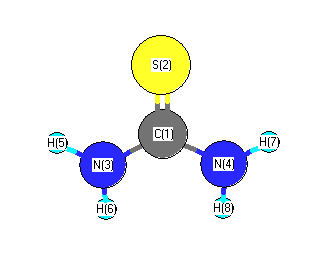Vibrational Frequencies calculated at B97D3/6-31G*
| Mode Number |
Symmetry |
Frequency
(cm-1) |
Scaled Frequency
(cm-1) |
IR Intensities
(km mol-1) |
Raman Act
(Å4/u) |
Dep P |
Dep U |
|---|
| 1 |
A |
3613 |
3542 |
7.97 |
|
|
|
| 2 |
A |
3476 |
3408 |
1.04 |
|
|
|
| 3 |
A |
1655 |
1622 |
51.88 |
|
|
|
| 4 |
A |
1404 |
1376 |
241.33 |
|
|
|
| 5 |
A |
1065 |
1044 |
50.26 |
|
|
|
| 6 |
A |
754 |
739 |
5.66 |
|
|
|
| 7 |
A |
563 |
552 |
119.37 |
|
|
|
| 8 |
A |
452 |
443 |
8.00 |
|
|
|
| 9 |
A |
378 |
371 |
101.20 |
|
|
|
| 10 |
B |
3612 |
3542 |
53.25 |
|
|
|
| 11 |
B |
3469 |
3401 |
20.95 |
|
|
|
| 12 |
B |
1629 |
1597 |
174.94 |
|
|
|
| 13 |
B |
1412 |
1384 |
88.14 |
|
|
|
| 14 |
B |
1075 |
1054 |
17.32 |
|
|
|
| 15 |
B |
629 |
617 |
140.54 |
|
|
|
| 16 |
B |
579 |
567 |
131.38 |
|
|
|
| 17 |
B |
428 |
420 |
207.89 |
|
|
|
| 18 |
B |
395 |
387 |
3.90 |
|
|
|
Unscaled Zero Point Vibrational Energy (zpe) 13293.3 cm
-1
Scaled (by 0.9804) Zero Point Vibrational Energy (zpe) 13032.8 cm
-1
See section
III.C.1 List or set vibrational scaling factors
to change the scale factors used here.
See section
III.C.2
Calculate a vibrational scaling factor for a given set of molecules
to determine the least squares best scaling factor.
Charges, Dipole, Quadrupole and Polarizability
Charges from optimized geometry at B97D3/6-31G*
Charges (e)
| Number |
Element |
Mulliken |
CHELPG |
AIM |
ESP |
| 1 |
C |
0.294 |
|
|
|
| 2 |
S |
-0.283 |
|
|
|
| 3 |
N |
-0.692 |
|
|
|
| 4 |
N |
-0.692 |
|
|
|
| 5 |
H |
0.358 |
|
|
|
| 6 |
H |
0.328 |
|
|
|
| 7 |
H |
0.358 |
|
|
|
| 8 |
H |
0.328 |
|
|
|
Electric dipole moments
Electric dipole components in Debye
(What's a Debye? See section
VII.A.3)
| |
x |
y |
z |
Total |
| |
0.000 |
0.000 |
-4.860 |
4.860 |
| CHELPG |
|
|
|
|
| AIM |
|
|
|
|
| ESP |
|
|
|
|
Electric Quadrupole moment
Quadrupole components in D Å
| Primitive |
|---|
| | x | y | z |
|---|
| x |
-33.269 |
3.055 |
0.000 |
| y |
3.055 |
-25.333 |
0.000 |
| z |
0.000 |
0.000 |
-29.145 |
|
| Traceless |
|---|
| | x | y | z |
|---|
| x |
-6.030 |
3.055 |
0.000 |
| y |
3.055 |
5.873 |
0.000 |
| z |
0.000 |
0.000 |
0.156 |
|
| Polar |
|---|
| 3z2-r2 | 0.312 |
|---|
| x2-y2 | -7.935 |
|---|
| xy | 3.055 |
|---|
| xz | 0.000 |
|---|
| yz | 0.000 |
|---|
|
Polarizabilities
Components of the polarizability tensor.
Units are
Å
3 (Angstrom cubed)
Change units.
| |
x |
y |
z |
| x |
3.047 |
0.199 |
0.000 |
| y |
0.199 |
6.218 |
0.000 |
| z |
0.000 |
0.000 |
9.443 |
<r2> (average value of r
2) Å
2
| <r2> |
102.350 |
| (<r2>)1/2 |
10.117 |
